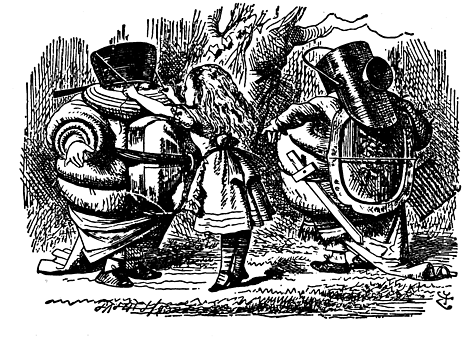The Red Queen:
parasitism, arms races, and the origin/maintenance of sexual reproduction
All of the costs of parasitism lead to ...

antagonistic coevolution between hosts and parasites, or
arms races.
But before we go there, let's (of course) take another detour ...
Sex and mating systems
Birds do it, bees do it, even educated fleas do it,
let's do it ...
Why do it? (reproduce sexually, that is)
In our self-centered way we (humans) tend to
assume that obligate, two-sex reproduction with
separate male and female organisms
(dioecy) whose sex is determined
genetically is the only way to go.
If you look around the tree of life a bit,
though, you realize that there are lots of other
alternatives.
Some of the alternatives, moving from clonality to
obligately dioecous, sexual organisms:
- Clonal (mitotic) reproduction (the most famous
clonal "higher" organ is Taraxacum, the
common dandelion): organisms simply produce offspring
that have exactly the same (haploid or diploid) genotype
- Selfing hermaphrodites undergo meiosis and
produce gametes, but then fuse two of their own gametes.
This process can also be known as a ploidy cycle,
since a diploid organism goes through a haploid stage even though it
has none of the other trappings of sex
(Kondrashov 1994,
Nature 370:213-26).
Selfing can be obligate or facultative in hermaphrodites:
many monoecious plants
can self-fertilize in a pinch.
(Monoecy means having male and female flowers
on the same plant; monoclinic plants are
hermaphroditic plants with pistils (male genitalia)
and stamens (female genitalia)
within the same flower.
- In outcrossing or non-selfing hermaphrodites
individuals can produce both male and female gametes (pollen/sperm and
eggs), but they cannot fuse their own gametes.
(Again, plants make a good comparison: many plants have
elaborate self-incompatibility systems to prevent selfing.)
- Finally, we get to dioecious individuals, where each
individual produces either male or female gameters (only).
As we will see, this range of possibilities
will allow us to dissect some of the different
costs and benefits of sex.
There are many taxa (unlike the very unusual
class Mammalia) where there are variations
in mating systems.
It's only when there is variation that
we can actually start to think about the evolutionary
pressures that lead to one system or another.
If there are different systems within a single populations,
within different populations within a species, or
within different closely related species, we can
begin to ask why and how it all works out.
But we also need to think about explaining
obligate sexuality and asexuality.
The costs of sex
One of the things we tend to miss as a result of our own, human
biology and culture is that in a perfect, homogeneous world where we
were just trying to produce as many copies of our genes as possible,
as quickly as possible (which is after all the name of the Darwinian
game), sex would be a really bad idea. (This is perhaps one of the
greatest strengths of theory in biology---making us see that trying to
explain some of the things we don't see in nature can provide
the best puzzles and the greatest insights, rather than just
explaining the things we do see.)
There are several problems with sex.
Reproductive assurance
In environments where population densities are very low, it
can be very hard to find a mate (or activities associated with mating
can be costly or risky).
Cost of males
Why spend time, energy and nutrients producing males when you could be
producing females? (Parthenogenetic females
manage quite happily producing females alone.)
Given that you only get one copy of your genes per
egg, shouldn't you be pumping out eggs as fast as possible? Doesn't
that mean the more females the better?
Cost of meiosis
Why pass on only one copy of your genes when you could
pass on two? This is often considered the strongest
and most basic cost of sex, because it imposes a 50%
fitness cost relative to asexual lineages: somehow,
sexuals have to be twice as fit to make up for the
cost of meiosis.
Cost of outbreeding
Too much variation could be bad, if sexual recombination
breaks up co-adapted gene complexes. This would lead
to what is called outbreeding depression;
hybrid sterility or inviability is the extreme case
of this, when an organism mates across species lines.
Q: which variants above (clonality, monoecy/dioecy,
selfing, etc.) have which of these disadvantages?

